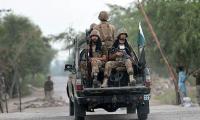Climate change is eating the Himalayan glaciers at a pace that, if left unabated, would threaten water supplies and life and livelihoods for hundreds of millions of people across South Asia.
The latest study has indicated that these glaciers are melting twice as fast they were in the past century. The study, for the first time, has heavily relied on declassified satellite images from the cold-war era consisting of almost 40 years of data spanning 2000 kilometres across China, India, Nepal, and Bhutan. The findings concluded that each year since 2000 the glaciers have been losing an equivalent of a foot-and-a-half of ice each year, double the amount of melt that took place from 1975 to 2000. The study concludes that the rising temperatures are the biggest factor contributing to the loss of glaciers, followed by changes in rainfall and the burning of fossil fuels.
Since the beginning of this year, many Indian states have been reeling under severe water scarcity. The situation has deteriorated as we witness the second driest pre-monsoon season in the last 65 years. According to the Drought Early Warning System (DEWS), the problem is pretty bad as the drought-like situation covers more than 44 percent geographic area, an increase of 11 percentage points over a year ago. In a recent report, India’s leading business daily, ‘The Hindu BusinessLine’, quoted India’s Ministry of Earth Sciences and the Ministry of Science and Technology as saying they have “found a significant increasing trend in the intensity and areal coverage of moderate droughts over India in recent decades”. It added that “more intense droughts have been observed over North and Northwest India and neighbouring Central India”.
Since 2015, drought has become more widespread in India – with the exception of 2017. The current spell of drought has emptied hundreds of villages across different provinces as people have fled extremely high temperatures abandoning homes in search of water and solace from the scorching sun. The acute water shortages have destroyed agriculture-based livelihoods as crops like cotton, maize, soya, pulses, and groundnuts have withered devastating local economies. In the past, crop failures and mounting debts have pushed hundreds of thousands of farmers to commit suicide, a trend that has seen a phenomenal increase in the last decade.
In Pakistan, the situation is no different. Drought has become a frequent phenomenon with the drought of 1998-2002 considered the worst in the country’s history. The express lack of any serious official planning coupled with corruption, uncontrolled human population, urbanisation, and absence of water management has aggravated the issue. A 2017 report from the Pakistan Council of Research in Water Resources (PCRWR) claimed the country had touched the “water stress line” in 1990, and a decade and a half later, it crossed the “water scarcity line” in 2005. The country is supposed to reach the “absolute scarcity” level of water by 2025.
Growing seasonal afflictions such as delay in the monsoon season or failure to get enough rains exacerbate the situation as rainfall has been steadily declining; this, according to experts, is being mainly linked to climate change. In Sindh and Balochistan, drought has almost become a permanent feature with deaths being reported regularly from Sindh, particularly in Tharparkar. But amid increasing political rancour and the perennial tussle between various state institutions, there is hardly any time to think about the future that, by various scientific studies, is not too distant in future and carries extremely grim predictions. Any failure in agriculture would choke Pakistan’s lifeline as about 60 percent of its GDP depends on agronomy.
One of the glaring malfunctions of Pakistani leadership has been a consistent failure since 1960 to build any new and significant dams that could store leaking water and harvest it to mitigate the growing energy crisis. In comparison, India has invested heavily in finding ways to manage and mitigate crises. In Jammu and Kashmir alone, it is spending $15 billion in water management focusing on building dams on the western waters that grant water rights to Pakistan under the Indus Waters Treaty. The seriousness of these projects could be gauged by the fact that last year Indian Prime Minister Narendra Modi suggested that Jammu and Kashmir could alone provide electricity to the whole of India.
The politics of India and Pakistan adds yet another, and potent, twist to the growing water crisis in the region. The increasing mutual trust deficit and growing rhetoric of the Indian leadership are fuelling speculations about a future ‘water war’ with Pakistan. Earlier this year, following attacks on the Indian army in Kashmir, India warned to stop water to Pakistan – a threat that has been repeated several times during Prime Minister Modi’s earlier government.
On one occasion, reacting to an attack on the army in Kashmir, he famously suggested that blood and water cannot flow together. Some have even suggested that India, as the upper riparian country, should withdraw from the Indus Waters Treaty that has successfully regulated water management between the two countries. In February this year, Nitin Gadkari, the then water resources minister publicly alluded to the “calls for India to prevent even a single drop of water from going to Pakistan”. While such pronouncements may be dismissed as hot air, they are bound to heighten existential anxieties and support permanent escalation further constricting any room for engagement. Some alarmist suggestions foresee an immediate nuclear war should India realise the threat.
Ashfaq Mahmood’s book, ‘Hydro-Diplomacy: Preventing water war between nuclear-armed Pakistan and India’ (Institute of Policy Studies, Islamabad: 2018) suggests a knowledge-driven approach to resolve issues between the two countries. “The institutions dealing with transboundary water issues in both Pakistan and India suffer from limitations of [the] horizon of knowledge and phobia of [a] backlash of decisions in wake of highly charged relations between the two countries”.
The book offers valuable inputs from a practitioner’s perspective but seems to discount the bad politics of the region and new geopolitical reasoning that is deliberately fuelling the discontent.
Twitter: @murtaza_shibli
An aeroplane of the national flag carrier of Pakistan is seen in this file photo. — AFPWhile Pakistan considers...
Representational image of a graph depicting various variables. — APP/FileInitiated by the centre and fiercely...
In this picture taken on April 16, 2023, people throng a market area during shopping in Lahore. — AFPOne of the...
Honour crimes also target men. In Sikandar Ali Lashari vs The State, SHC upheld conviction passed by ATC for honour...
If Sindh earmarks Rs20 million per police station, it will cost only Rs10 billion to make them effective first...
A complex and difficult policy environment seems to be highlighted by US’s recent application of sanctions on...







